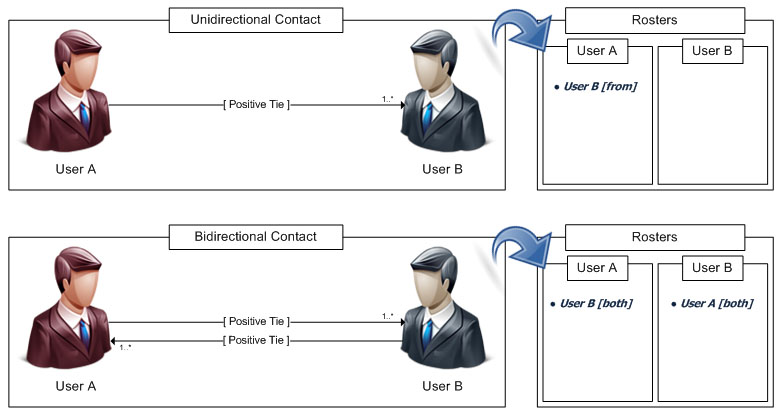-
Notifications
You must be signed in to change notification settings - Fork 307
Emanagement guide
Emanagement it's a ruby script that provides important functions to manage ejabberd rosters and other features using ejabberdctl, a control interface of Ejabberd server, designed to help the administrator control the functioning of the running ejabberd daemon.
We assume that the reader has some knowledge in XMPP protocol, otherwise, take a look at the XMPP RFC.
-
Jabber Identifiers (JIDs) uniquely identify individual entities in the Jabber network. Read more.
-
In XMPP, one's contact list is called a roster, which consists of any number of specific roster items, each roster item being identified by a unique JID (usually of the form contact@domain). A user's roster is stored by the user's server on the user's behalf so that the user may access roster information from any resource.
As we can see in the Social Stream Presence architecture scheme, our Xmpp Server only stores users's roster, it don't stores usernames and passwords, the authentication service is provided by the Social Stream Rails Application, therefore we will not have registered users in our xmpp server.
In Social Stream, the user's JID has the following structure: slug@domain .
Social Stream user's slug is building from the name, converting it to lowercase and replacing spaces with underscores. For example, if the user name is "Jonh Doe", the slug will be "jonh-doe".
If a user wants to know his slug, he can visit http://domain/api/me after log in, and get it from the slug's tag <slug>user's slug</slug>.
Shoulders to the wheel!
- Reflect Social Stream's contacts to rosters.
- Managing rosters with Emanagement
- Option 3
- Option 4
- Option 5
We assume that the reader is already familiar with Social Stream Base.
- A Contact is a link between two actors.
- Each contact has many ties, which determine the kind of the link through relations.
- Each Activity is attached to a contact. The sender of the contact is the author of the activity and the receiver actor of the contact is the receiver of the activity.
In this guide, in a simple way, we will only differentiate between two types of contacts:
- Unidirectional: When the Contact in the other way isn't established (or negative replied).
- Bidirectional: When the Contact in the other way is established and positive replied.

Coming soon...